This report covers:
- The test
- JSB Exact .30 caliber 50.15-grains
- JSB 50-grain group 2
- Hard to cock
- JSB Exact 44.75-grain
- JSB KnockOut slugs
- Discussion
- Summary
Today we test the accuracy of the .30 caliber Umarex Gauntlet 2. I must admit I was pleasantly surprised by its performance.
The test
Given the power of the .30 caliber Gaunltlet, plus the discharge noise, I had to test it at my rifle range. I could have run a 25-yard test there, but since 50 yards was available I decided, why not?
I shot 7-shot groups because that is what the circular magazine holds. However, in one test I shot just five shots.
The weather was perfect. There was no wind on this morning, so all shots went where they did on purpose with no outside interference. Let’s get started
JSB Exact .30 caliber 50.15-grains
The first pellet I tested was the JSB Exact .30 caliber pellet that weight 50.15-grains. Sight-in was special, so let me tell you about it.
I scoped the rifle with an older Hawke 4.5-14X42 Sidewinder scope in Meopta rings.
I was alone on the range. That means I could walk forward of the firing line, so I did. I went up to about 30 feet from the target. I always back my targets for these 50-yard tests with target paper measuring 2 feet wide by three feet high. That way if the rifle is hitting off the target paper I can usually see where the shots go. My first shot hit above the target paper because I had shimmed the rear scope ring. Knowing that at 50 yards it would drop some, I went back to the shooting bench and cranked the elevation adjustment down a lot — but not too much. It was less than a full turn of the elevation knob.
The second shot hit on the target paper about 4 inches below the aim point and 1.25-inches to the left. I dialed the scope’s adjustments up and to the right and the shot climbed two inches and also went one inch to the right. One more adjustment hit just outside the bull I aimed at. It hit just outside the black at 7 o’clock so I decided to leave the scope there and shoot a group of 7.
The first group of seven pellets measures 1.354-inches between centers. The last shot is the one on the lower left. Phooey!
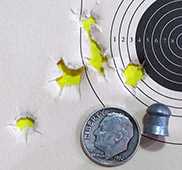
The first group of seven JSB Exact 50.15-grain pellets made a 1.354-inch group at 50 yards.
Following this group I adjusted the scope both up and to the right. I wanted the pellets in the black, but to preserve the center dot aim point.
JSB 50-grain group 2
The next group hit the target where I wanted, so I didn’t adjust the scope again in this test. Five 50.15-grain pellets went into 1.028-inches between centers at 50 yards. That’s minute-of-coyote or bobcat accuracy for sure.
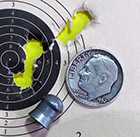
The second group of five JSB 50.15-grain pellets measures 1.028-inches between centers at 50 yards.
Hard to cock
I found the .30 caliber Gauntlet very hard to cock on this morning. Once I even failed to cock it and had to remove the magazine to prevent a double feed. I mention this because I believe there was some discussion about it. I filled the reservoir after this group, so there were a total of 16 shots on the last fill. My carbon fiber tank has long since lost its air to fill to 4,350 psi. There may be 3,800 psi remaining in the tank.
JSB Exact 44.75-grain
The next pellet I tried was the 44.75-grain JSB. I didn’t change the scope for this because I wanted to see what this lighter pellet would do. Seven of them made a 0.866-inch group at 50 yards. This group hit the target nearly one inch higher than the heavier 50.15-grainer, so now we know.
This is the smallest group of the test. It is so much smaller than groups made by any other pellet tested that I have to declare this pellet is the best one for the Gauntlet 30 — at least of the ones I tried.
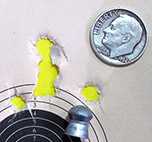
The .30 caliber Gauntlet put seven JSB Exact 44.75-grain pellets into a 0.866-inch group at 50 yards.
JSB KnockOut slugs
The last pellet I tested was the 50.15-grain JSB KnockOut hollowpoint slug. I knew some of you would want to know about slugs and when I ordered my ammo this was the only one available.
The KnockOuts hit the target considerably below where the 50.15-grain JSB domes had hit after the final scope adjustment and I presume that is because they are traveling slower. More of their body contacts the rifling and the additional friction must slow them down.
Seven slugs landed in a 1.644-inch group at 50 yards. It’s the largest group of the test. I would not choose this round for the .30-caliber Gauntlet.
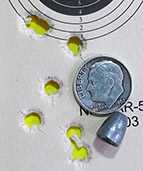
The .30 caliber Gauntlet put seven JSB KnockOut hollowpoint slugs into a 1.644-inch group at 50 yards. It’s the largest group of the test.
Discussion
The .30-caliber Umarex Gauntlet 2 is a good big bore air rifle that can deliver around 100 foot-pounds of energy at the muzzle. It is a repeater, which is unusual in a big bore. I saw 28 good shots per 4,350 psi fill. The lower power level, the super-high fill pressure, plus the smaller bore diameter are all factors that contribute to the higher shot count.
The Gauntlet 2 is huge! It’s long, wide and heavy. It’s a rifle you would want to sit in a stand with, but not to carry as you trudge around the field.
Cocking is heavy. The bolt comes back easily enough until it’s three-quarters back and then it takes some real muscle to finish the stroke. I found myself putting the bolt handle intentionally into the rear slot of the receiver, to ensure that I completed the cocking cycle.
The price is very low for all that you get. And that is certainly a factor to consider when buying any big bore.
Summary
The .30 caliber Umarex Gauntlet 2 is an interesting big bore air rifle. You could think of it as a happy medium between a smallbore PCP and an all-out thumper big bore that only shoots cast lead bullets. The low price is certainly a strong point in its favor.


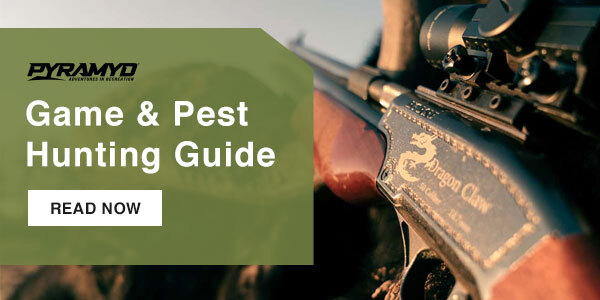
B.B.
How about a series on double(or more) feeds? What causes them and how they can be eliminated or reduced.
What to do if 2 or 3 or 4 pellets are stuck in your barrel?
-Y
PS Thank goodness, us single shot springer people do not have to worry about that! HA HA HA.
Yogi,
Let me give that some thought.
BB
Yogi,
Actually, single shot springer people DO have to worry about sticking pellets in the barrel. Tomorrow,
BB
Actually, when I shot my Diana 5 G for the first time in 25 years, the first shot went “fizzt”. The second pellet never left the barrel.
-Y
Yogi,
Yep! It does happen like that.
BB
BB,
An interesting air rifle with an interesting caliber. I had heard that the 44.75 grain JSB was more accurate than the 50.15 grain JSB in most .30 caliber air rifles.
This air rifle and caliber may be a decent “long range” thumper for large varmint hunting, but it is seriously lacking in the accuracy department. Now, having said that, if the power was dialed back a bit, it will likely increase the accuracy. Of course, there are other factors to consider with this particular air rifle. It may also be in need of a different barrel.
For the price, this is not a bad intro into big bore.
I notice that our ‘host’ appears without the bracketed extension in his username. And the avatar has gone as has the customary footnote below today’s article / blog. Seems like a fresh start. 🙂
3hi,
I would not read too much into these things. It could be just another WordPress thing. I have not been very impressed with what I have seen from them. Apparently, they are very cheap compared to the competition.
BB,
Don’t think it is worth while to test slugs in a “pellet gun” that doesn’t have the correct barrel (twist rate) or has been tuned to that particular brand/diameter/weight of slug.
Cataracts delayed my slug project so I’m just starting to explore them now. From my research and (limited) testing it seems that all the planets have to be lined up right to get stable flight. Harmonics and fine tuning are as important as the slug, barrel and fit. Randomly trying slugs is like playing the lottery 🙂
Over the decades (centuries?) bullet design has been fine tuned. Seems that there is a lot of research and development going on to get to the same level for airgun slugs. Inconsistencies in airgun barrels is really making things difficult for everybody.
If you are going to try slugs in the higher power PCPs I’d suggest that you use the FX Hybrid slugs for a baseline as their balance and hollow design let’s them play well with many pellet barrels. The fit (slug to barrel diameter) is critical for “solid” slugs.
As far as the current state of slugs and airguns goes, 100 fpe, 1000 + fps and minute-of-a-pigeon accuracy at 150 + yards with .22 caliber 40 grain slugs is routine in South Africa. The channel (AirTac Hunting) is heavy into slug development with their Patriot brand of Javelin slugs. In North America, .25 and .30 projectiles are seeing development as well but don’t seem as advanced as the .22 caliber work.
I don’t “need” slugs and prefer pellets in my airguns but I find this technology to be too interesting to ignore. Going to be a fun project 🙂
Hank
B.B.,
Interesting report and for what it is good groups for the Gauntlet.
I will note that your groups have a seeming vertical bias. Coincidentally I have been researching the impact of various bench techniques on the vertical of group sizes. One shooters feels that after the optimum forend position has been optimized on the front rest the rear rest is the source of much of the vertical in groups.
Are you using a rear rest? If you could half the vertical dispersion of most all of the above groups the reduction in group size would be substantial.
Also are you using a cant level and is it on the rail or scope body?
shootski
shootski,
No rear rest. I level with the horizontal reticle over the center of the bulls.
BB
B.B.,
Thank you.
shootski
Shootski,
Will have to watch for that! Saw some vertical stringing yesterday and I was moving the rifle around a bit.
Cant is really noticeable at the 40 yards I test at as well. The smooth, round bottle on the Impact pivots too easily LOL! I put some of that rubberized “shelf liner” on the rest to tame that and it is helping.
Hank